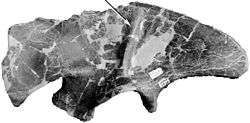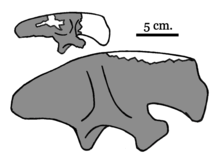Stokesosaurus
| Stokesosaurus Temporal range: Late Jurassic, 150 Ma | |
|---|---|
 | |
| Holotype UMNH VP 7473 | |
| Scientific classification | |
| Kingdom: | Animalia |
| Phylum: | Chordata |
| Class: | Reptilia |
| Clade: | Dinosauria |
| Order: | Saurischia |
| Suborder: | Theropoda |
| Family: | †Proceratosauridae |
| Genus: | †Stokesosaurus Madsen, 1974 |
| Species: | †S. clevelandi |
| Binomial name | |
| Stokesosaurus clevelandi Madsen, 1974 | |
Stokesosaurus (meaning "Stokes' lizard") is a genus of small (around three to four meters (10-13 ft) in length), carnivorous early tyrannosauroid theropod dinosaurs from the late Jurassic period of Utah.
History


From 1960 onwards Utah geologist William Lee Stokes and his assistant James Madsen excavated thousands of disarticulated Allosaurus bones at the Cleveland-Lloyd Dinosaur Quarry in Emery County, Utah. During the early seventies Madsen began to catalogue these finds in detail, discovering that some remains represented species new to science. In 1974 Madsen named and described the type species Stokesosaurus clevelandi. Its generic name honours Stokes. The specific name refers to the town of Cleveland, Utah.[1]
The holotype (UUVP 2938) was uncovered in the Brushy Basin Member of the Morrison Formation dating from the early Tithonian stage, about 150 million years old. It consists of a left ilium or hip bone, belonging to a juvenile individual. Madsen also assigned a paratype, UUVP 2320, a 50% larger right ilium. Additionally he referred a right premaxilla, UUVP 2999.[1] However, this was in 2005 referred to Tanycolagreus.[2] Stokesosaurus and Tanycolagreus are about the same size, and it is possible that the latter is a junior synonym of the former. However, the ilium (the best and perhaps only known element of Stokesosaurus) of Tanycolagreus has never been recovered, making direct comparison difficult.[3]
In 1976 Peter Malcolm Galton considered Stokesosaurus to be a second species of the British possible early tyrannosauroid Iliosuchus, that he named as Iliosuchus clevelandi.[4] This has found no acceptance among other researchers;[5] in 1980 Galton himself withdrew his opinion.[6]

Some later finds were referred to Stokesosaurus. This included some ischia and tail vertebrae in 1991,[7] and a partial braincase in 1998.[8] Another, very small ilium referred to Stokesosaurus, found in South Dakota,[9] is lost but may actually belong to the related Aviatyrannis.[10] More fragmentary remains possibly referable to Stokesosaurus have been recovered from stratigraphic zone 2 of the Morrison Formation, dated to the late Kimmeridgian age, about 152 million years ago.[11][12]
A second species, Stokesosaurus langhami, was described by Roger Benson in 2008 based on a partial skeleton from England.[5] However, further study showed that this species should be referred to a new genus, which was named Juratyrant in 2012. Benson and Stephen Brusatte concluded that not a single bone had been justifiably referred to Stokesosaurus, and that not even the paratype could be safely assigned, leaving the holotype ilium as the only known fossil of the taxon.[13]
The holotype ilium is twenty-two centimetres long, indicating a small individual. Madsen in 1974 estimated that the adult body length was about four metres.[1] In 2010 Gregory S. Paul estimated the length at 2.5 metres, the weight at sixty kilogrammes.[14] In 2012 Benson and Brusatte established a single unique derived trait or autapomorphy of Stokesosaurus: the normally vertical ridge on the outer blade surface of the ilium, above the hip joint, was strongly inclined to the back and reached the upper rim of the blade.[13]
Classification
In 1974 Madsen assigned Stokesosaurus to the Tyrannosauridae.[1] However, modern cladistic analyses indicate a more basal position. In 2012 the study by Brusatte and Benson recovered Stokesosaurus as a basal member of the Tyrannosauroidea, and closely related to Eotyrannus and Juratyrant.[13]
Below is a 2013 cladogram by Loewen et al. that places Stokesosaurus as an advanced Proceratosaurid.[15]
| Tyrannosauroidea |
| |||||||||||||||||||||||||||||||||||||||||||||||||||||||||||||||||||||||||||||||||||||||||||||
| |
Paleoecology
Habitat
The Morrison Formation is a sequence of shallow marine and alluvial sediments which, according to radiometric dating, ranges between 156.3 million years old (Ma) at its base,[16] to 146.8 million years old at the top,[17] which places it in the late Oxfordian, Kimmeridgian, and early Tithonian stages of the Late Jurassic period. This formation is interpreted as a semiarid environment with distinct wet and dry seasons. The Morrison Basin where dinosaurs lived, stretched from New Mexico to Alberta and Saskatchewan, and was formed when the precursors to the Front Range of the Rocky Mountains started pushing up to the west. The deposits from their east-facing drainage basins were carried by streams and rivers and deposited in swampy lowlands, lakes, river channels and floodplains.[18] This formation is similar in age to the Solnhofen Limestone Formation in Germany and the Tendaguru Formation in Tanzania. In 1877 this formation became the center of the Bone Wars, a fossil-collecting rivalry between early paleontologists Othniel Charles Marsh and Edward Drinker Cope.
Paleofauna
The Morrison Formation records an environment and time dominated by gigantic sauropod dinosaurs such as Camarasaurus, Barosaurus, Diplodocus, Apatosaurus and Brachiosaurus. Dinosaurs that lived alongside Stokesosaurus included the herbivorous ornithischians Camptosaurus, Dryosaurus, Stegosaurus and Othnielosaurus. Predators in this paleoenvironment included the theropods Saurophaganax, Torvosaurus, Ceratosaurus, Marshosaurus, Ornitholestes and[19] Allosaurus, which accounting for 70 to 75% of theropod specimens and was at the top trophic level of the Morrison food web.[20] Other animals that shared this paleoenvironment included bivalves, snails, ray-finned fishes, frogs, salamanders, turtles, sphenodonts, lizards, terrestrial and aquatic crocodylomorphans, and several species of pterosaur. Examples of early mammals present in this region, were docodonts, multituberculates, symmetrodonts, and triconodonts. The flora of the period has been revealed by fossils of green algae, fungi, mosses, horsetails, cycads, ginkgoes, and several families of conifers. Vegetation varied from river-lining forests of tree ferns, and fern (gallery forests), to fern savannas with occasional trees such as the Araucaria-like conifer Brachyphyllum.[21]
See also
References
- 1 2 3 4 Madsen, J. H. (1974). "A new theropod dinosaur from the Upper Jurassic of Utah". Journal of Paleontology. 48: 27–31.
- ↑ K. Carpenter, C.A. Miles, and K.C. Cloward, 2005, "New small theropod from the Upper Jurassic Morrison Formation of Wyoming", In: K. Carpenter (ed.), The Carnivorous Dinosaurs. Indiana University Press, Bloomington pp. 23-48
- ↑ Foster, J. (2007). Jurassic West: The Dinosaurs of the Morrison Formation and Their World. Indiana University Press. 389pp.
- ↑ Galton, P. M. (1976). "Iliosuchus, a Jurassic dinosaur from Oxfordshire and Utah". Palaeontology. 19: 587–589.
- 1 2 Benson, R.B.J. (2008). "New information on Stokesosaurus, a tyrannosauroid (Dinosauria: Theropoda) from North America and the United Kingdom." Journal of Vertebrate Paleontology, 28(3):732-750. doi:10.1671/0272-4634(2008)28[732:NIOSAT]2.0.CO;2.
- ↑ Galton, P.M. and Powell, H.P., 1980, "The ornithischian dinosaur Camptosaurus prestwichii from the Upper Jurassic of England", Palaeontology, 23: 411-443
- ↑ Britt, B., 1991, "Theropods of Dry Mesa Quarry (Morrison Formation, Late Jurassic), Colorado, with emphasis on the osteology of Torvosaurus tanneri", Brigham Young University Geology Studies, 37: 1-72
- ↑ Chure, D.; Madsen, James (1998). "An unusual braincase (?Stokesosaurus clevelandi) from the Cleveland-Lloyd Dinosaur Quarry, Utah (Morrison Formation; Late Jurassic)". Journal of Vertebrate Paleontology. 18 (1): 115–125. doi:10.1080/02724634.1998.10011038.
- ↑ Foster, J.; Chure, D. (2000). "An ilium of a juvenile Stokesosaurus (Dinosauria, Theropoda) from the Morrison Formation (Upper Jurassic: Kimmeridgian), Meade County, South Dakota". Brigham Young University Geology Studies. 45: 5–10.
- ↑ Oliver W. M. Rauhut. (2003). "A tyrannosauroid dinosaur from the Upper Jurassic of Portugal". Palaeontology 46(5): 903–910
- ↑ Turner, C.E. and Peterson, F., (1999). "Biostratigraphy of dinosaurs in the Upper Jurassic Morrison Formation of the Western Interior, U.S.A." Pp. 77–114 in Gillette, D.D. (ed.), Vertebrate Paleontology in Utah. Utah Geological Survey Miscellaneous Publication 99-1.
- ↑ Foster, J. (2007). "Appendix." Jurassic West: The Dinosaurs of the Morrison Formation and Their World. Indiana University Press. pp. 327-329.
- 1 2 3 Brusatte, S.L. and Benson, R.B.J. (In press). "The systematics of Late Jurassic tyrannosauroids (Dinosauria: Theropoda) from Europe and North America." Acta Palaeontologica Polonica, (in press). doi:10.4202/app.2011.0141
- ↑ Paul, G.S., 2010, The Princeton Field Guide to Dinosaurs, Princeton University Press p. 100
- ↑ Loewen, M.A.; Irmis, R.B.; Sertich, J.J.W.; Currie, P. J.; Sampson, S. D. (2013). Evans, David C, ed. "Tyrant Dinosaur Evolution Tracks the Rise and Fall of Late Cretaceous Oceans". PLoS ONE. 8 (11): e79420. doi:10.1371/journal.pone.0079420.
- ↑ Trujillo, K.C.; Chamberlain, K. R.; Strickland, A. (2006). "Oxfordian U/Pb ages from SHRIMP analysis for the Upper Jurassic Morrison Formation of southeastern Wyoming with implications for biostratigraphic correlations". Geological Society of America Abstracts with Programs. 38 (6): 7.
- ↑ Bilbey, S.A. (1998). "Cleveland-Lloyd Dinosaur Quarry - age, stratigraphy and depositional environments". In Carpenter, K.; Chure, D.; and Kirkland, J.I. (eds.). The Morrison Formation: An Interdisciplinary Study. Modern Geology 22. Taylor and Francis Group. pp. 87–120. ISSN 0026-7775.
- ↑ Russell, Dale A. (1989). An Odyssey in Time: Dinosaurs of North America. Minocqua, Wisconsin: NorthWord Press. pp. 64–70. ISBN 978-1-55971-038-1.
- ↑ Foster, J. (2007). "Appendix." Jurassic West: The Dinosaurs of the Morrison Formation and Their World. Indiana University Press. pp. 327-329.
- ↑ Foster, John R. (2003). Paleoecological Analysis of the Vertebrate Fauna of the Morrison Formation (Upper Jurassic), Rocky Mountain Region, U.S.A. New Mexico Museum of Natural History and Science Bulletin, 23. Albuquerque, New Mexico: New Mexico Museum of Natural History and Science. p. 29.
- ↑ Carpenter, Kenneth (2006). "Biggest of the big: a critical re-evaluation of the mega-sauropod Amphicoelias fragillimus". In Foster, John R.; Lucas, Spencer G. Paleontology and Geology of the Upper Jurassic Morrison Formation. New Mexico Museum of Natural History and Science Bulletin. 36. Albuquerque, New Mexico: New Mexico Museum of Natural History and Science. pp. 131–138.
